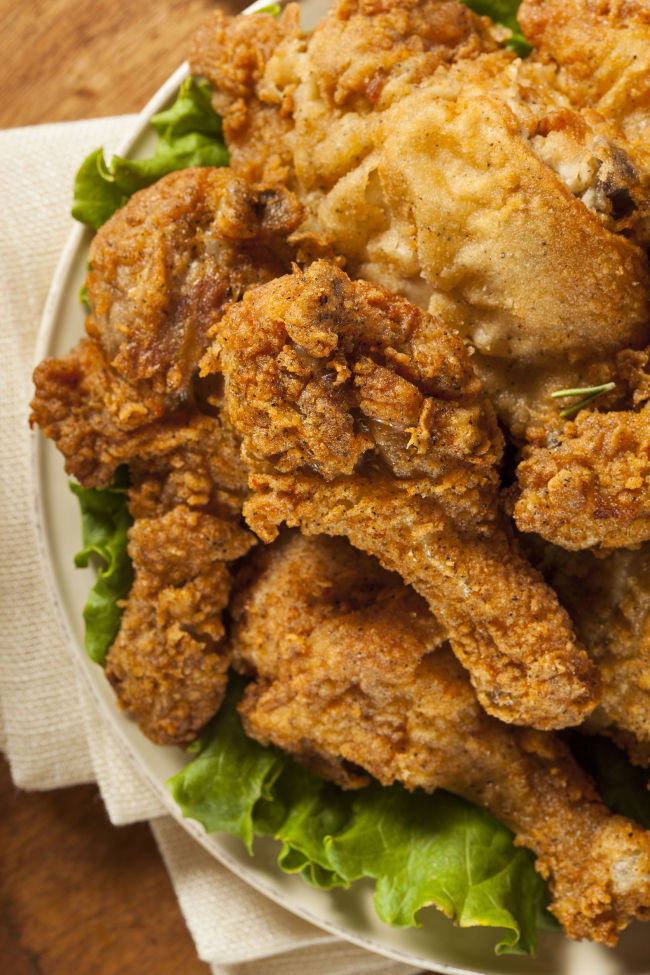"Chicken Republic” refers not just to the abundant chicken eateries in Korea, but also shows how the fowl has affected the nation’s food culture and industrial map.
Over the decades, chicken has evolved into everyday comfort food and it has even become representative of Korea’s food culture.
According to latest statistics, each Korean consumes an average of 15.4 kilograms of chicken a year. They are used in numerous dishes ranging from samgyetang (chicken in broth) to dakbokeumtang (chicken stewed in spicy sauce).
Over the decades, chicken has evolved into everyday comfort food and it has even become representative of Korea’s food culture.
According to latest statistics, each Korean consumes an average of 15.4 kilograms of chicken a year. They are used in numerous dishes ranging from samgyetang (chicken in broth) to dakbokeumtang (chicken stewed in spicy sauce).

But at the core of the meat’s popularity is the Korean-style fried chicken, which combines western cooking techniques and oriental seasonings to suit the palate of the Korean consumers.
This fusion dish, which differs from traditional Korean chicken recipes, is referred to as “chikin (fried chicken)” instead of the Korean equivalent “dak twigim.”
Chicken has also grown in popularity over recent years due to the rise of “chi-maek,” a word that combines chicken and beer.
“Inviting somebody to have chi-maek carries a completely different tone from suggesting other get-togethers,” said Jeon Seung-wook, a 34-year-old office worker.
“While it is filling enough to be counted as a full meal, chicken is much more casual as it is served in fully cooked pieces, allowing people to focus more on conversation.”
This easygoing mood, along with the affordable price, is what makes chicken accessible to workers who get-together on weeknights or families and even single households looking for an easy home-delivery meal.
Chicken joins in K-food wave
Given its steady demand and frequent media exposure, chicken has become a popular item of the Korean culinary wave, especially in neighboring China.
It was the hit SBS drama “My Love from the Star” that aired in 2013-2014 which brought Korean-style chicken to the attention of the Chinese public.
After the release of a scene in which the drama’s heroine Jun Ji-hyun cheered up over chi-maek, holding a chicken drumstick in one hand and a cup of beer in the other, Chinese fans queued for hours at Korean chicken stores.
Travel agencies immediately added chicken meals to their tourist programs, while chicken companies and regional governments mulled using chicken as a cultural promotion tool.
In March this year, Incheon City made headlines by hosting a chicken and beer street promotion for 4,500 Chinese visitors who consumed some 3,000 chickens in one sitting.
“Despite its western-based origin, chicken is now quite fit to represent Korea’s popular food culture, especially in a foreigner’s perspective,” said Kim Sook-hyun, a Korean female residing in New York. She previously spent several years in Berlin, Germany.
Although chicken is familiar to them, westerners tend to be intrigued by the Korean twist such as the spicy sauces, she explained.
“In fact, one of the things that I missed most about home during my stay in Europe was seasoned spicy chicken, not tteokbokki or any other conventional Korean-style snacks,” she added.
“It was the menu that reminded me of home -- that existed in so many parts of my memory back there, so why wouldn’t I see it as Korean food?”
Chicken game of the chicken sellers
While overseas demand has opened up new doors for Korea’s chicken industry, it has also egged on competition in the already saturated market.
According to the Statistics Korea and Fair Trade Commission early this year, Korea’s chicken market currently stands at 5 trillion won ($4.2 billion) in size, comprising of some 40,000 stores and 300 franchise brands.
The number of stores exceeds the global total of fast food giant McDonald’s or the No. 1 chicken franchise Kentucky Fried Chicken. The former held 36,525 stores worldwide as of last year and the latter 18,875 as of 2014.
If non-franchise owner stores and beer pubs selling chicken menus are included, the number of chicken sellers in Korea is likely to be much higher than the commission’s figures.
This oversupply has inevitably led to a mass fallout. Seoul Metropolitan Government data in February showed that the number of chicken stores in the city soared by 38 percent in 2010-2015, but an equal number also closed down within the first three years in business.
Despite this trend, aspiring owner-operators still opt to open such stores as it seems a plausible way of creating income on limited capital, given the simple recipe and menu
Maintenance and personnel expenses are also lower compared to other restaurant businesses, especially in the case of delivery-only stores.
“Our country is like a chicken republic, where elderly retirees have no other way than opening a (chicken) store, regardless of their occupational skills,” said President Park Geun-hye during a financial strategic meeting last month.
Her remarks were made in support of a labor bill permitting the dispatch of elderly workers to correlated small and medium-sized companies. However, it also highlights the excessive boom of the market.
Observers noted that those who seek to open such businesses should recognize the tough market situation before hastily opening a chicken franchise store.
“Franchise headquarters would boast guaranteeing the operator a certain monthly income, but these stated figures often turn out to be delusive,” said an official of the FTC.
“One also has to consider the surrounding elements, such as the number of competing stores in proximity and the public image of the franchise brand itself.”
By Bae Hyun-jung (tellme@heraldcorp.com)
-
Articles by Korea Herald







![[Weekender] Geeks have never been so chic in Korea](http://res.heraldm.com/phpwas/restmb_idxmake.php?idx=644&simg=/content/image/2024/05/16/20240516050845_0.jpg&u=)



![[Herald Interview] Byun Yo-han's 'unlikable' character is result of calculated acting](http://res.heraldm.com/phpwas/restmb_idxmake.php?idx=644&simg=/content/image/2024/05/16/20240516050855_0.jpg&u=)






![[Herald Interview] Byun Yo-han's 'unlikable' character is result of calculated acting](http://res.heraldm.com/phpwas/restmb_idxmake.php?idx=652&simg=/content/image/2024/05/16/20240516050855_0.jpg&u=)
